Spoilers Spoilers Spoilers Spoilers
If you have not seen this movie, know that this review will contain plenty of spoilers.

I went to see this and guess what? I got thinky thoughts!
The Personal
This movie was a very emotional experience for me. I really got into the characters and situations presented here, and I’m baffled that some people were baffled by this movie, but then I’ve had many years of practice trying to understand the plots of weird horror movies. Most of the puzzlement I’ve read comes from people who don’t regularly watch horror movies. If you’re not a fan of horror movies, and don’t watch them all the time, its best to go in thinking of this film as if it were a dream. There’s a lot of what we call “Dream Logic”. and some of the imagery will fly right over the heads of people who have never thought about movies this way.
This movie has been really polarizing, with people loving it or hating it, and that’s understandable. Peele made the decision to add a lot of depth to Us. Its a movie that addresses many issues, and is meant to be heavily analyzed, but how you look at it says a lot about what you feel, and what your priorities are. Peele also doesn’t tell you how to feel about the movie, or its characters, and some people hated that. The end of the movie was unsettling for a lot of people. My Mom didn’t care for the movie, saying it ended badly, but she is one of those people who likes her horror to be very clear and straightforward. She likes a clear case of who the heroes and villains are in a movie, and she disliked having rooted for the protagonist for the entire movie, only to have that turned on its head at the end.
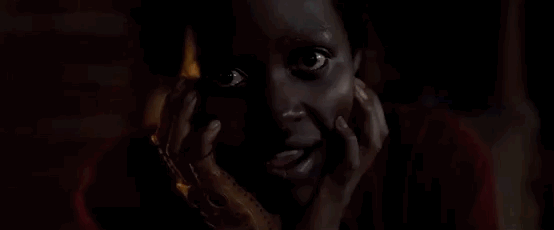
On the other hand, I’m okay with ambiguity. I’m uncomfortable with having rooted for what I thought was the hero of the movie, but I’m going to sit with that feeling, process it, and figure out what I think about it. There were a lot of moments in the movie that had an unexpected affect on me. One of the most horrific moments in the movie is when the Tethered child died in flames, echoing Red’s statement that he had been born in flames. (But I have some serious fire fear, so…). The movie felt unfinished, because usually at the end of horror movies, the evil has been vanquished, and the status quo, which had been disrupted by the monster, has been restored. This movie doesn’t really have a monster, or a villain or even a hero. Things do not go back to the way the movie began.
Because of the ending, the movie felt melancholy and tragic, reminding me heavily of Annihilation, a movie that produced much the same feeling.. But Us also had moments of real humor, where we (the audience) just laughed out loud. I’ve often asserted that laughter lies on one side of a coin, with terror on the other. Peele himself has said he likes to take innocent, innocuous things, and imbue them with dread and horror, and he succeeded. I expect that I will never hear the song, “I Got Five On It”, or “Fuck the Police”, ever again, without thinking of this movie, and I’ll never look at rabbits the way I used to.
I described this movie as a cross between CHUD, a movie about Cannibalistic Humanoid Underground Dwellers coming up from below, Invasion of the Bodysnatchers, as it deals with cloning, and identity, and Halloween, because of the red jumpsuits and sharp pointy weapons, which remind me of Michael Myers. Well, lets just say, I have a different set of references to this movie.

Here’s an interesting video from Latasha about the significance of some of the symbols, colors, and moments, in the movie. There are far too many to catch all of them after just one viewing. She discusses the movie in great detail, though, especially the idea of trauma and mirroring:
The Movie

The movie opens in the 80s, with little Adelaide watching an ad for the 1986 charity event, Hands Across America, which I’m old enough to remember. This is a key component of the film. In fact, everything you need to know is laid out at the beginning of the movie, just without any context, so you don’t put the whole puzzle together until somewhere in the middle of the film. Adelaide attends a carnival on the beach with her family. She wanders away from her bickering parents, into a mirrored funhouse, that has the proclamation : Find Yourself Inside, which she unexpectedly does, to her detriment. One of the most interesting clues is that Adelaide whistles Itsy Bitsy Spider on key, but her double can’t. I think the Itsy Bitsy Spider is a reference to Adelaide’s double, who has climbed up from below, to capture her.
Adelaide gets kidnapped by her double, another key component of this movie, and the motivation behind every decision that gets made, and she gets trapped in the underground hell where her double used to live. Her double is actually a clone of her, but without a soul. Because she has no soul, Adelaide has no sense of rhythm, (or beat), which I find hilarious, because in American culture, Black people joke about people who cannot dance on the beat, or have no rhythm, and are said to lack “Soul“.
There’s an old sketch I’m reminded of from the movie, Amazon Women on The Moon, which is also from a Black filmmaker, Robert Townsend. I know for an absolute certainty that Jordan Peele has seen this, and included just this tiny bit of this element into his depiction of the Tethered. Notice that neither Adelaide, nor her son Jason are capable of snapping their fingers to the beat of the song, snapping instead on the 1 and the 3, instead of the 2 and the 4.
The underworld Red comes from is full of the clones of the people who live above ground, and who are the failed result of a government experiment to control the American people. It’s left for the audience to decide if all Americans were cloned, or just half, or just enough of them to be dangerous. The clones have no souls, hence they have no vision, imagination, ambitions, or sense of self. They don’t even have language, and Adelaide, because she is human, and remembers the world above (the other clones have no knowledge of the above world), becomes their leader. Over the next thirty years, using her childhood memories of Hands Across America, and Michael Jackson, along with a great deal of rage, she organizes The Tethered to invade the above world, and kill their counterparts. It’s a literal uprising. Adelaide is so enraged at what was done to her, the Tethered have adopted some of that.
Adelaide, Red, (and their families), spend the rest of the movie playing a murderous game of cat and mouse, against the apocalyptic event of The Tethered coming from underground to kill their doubles, and stage their version of Hands Across America. I specifically remember this event, including the theme song in the ads. I was a teenager at the time, and distinctly remember scoffing at the idea that it would be at all helpful, or useful. And guess what? It wasn’t! The event was kind of a failure although it turned out to be the high point of the life of the person who orchestrated the event.
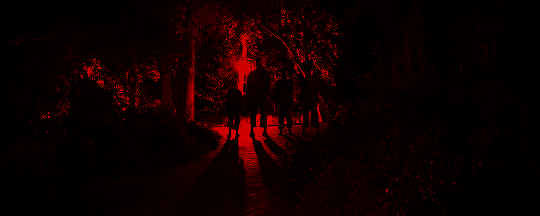
In the end, Adelaide, the character we’ve been rooting for the entire movie, turns out to be the double from the underworld, while Red is that long ago human girl, who dreamed of getting out of the hell her life had become, through Adelaide’s actions. According to Red, life underground is pretty bleak. Because they have no sense of self, the Tethered are forced to mimic the actions of their doubles, and none of them have ever had cooked food, feeding exclusively on the rabbits that have overbred in that environment. (This explains why Adelaide is a vegetarian.)
In other words, the Tethered are uncivilized, barbaric mirrors of their above ground counterparts, (through no fault of their own.) They act like animals, running on all fours, howling and grunting.They don’t know enough to know what or where they are, until Red teaches them, which she is only able to do because she came from above ground. She is their M.L.K. She is their Malcolm X. She had a “vision”.
This movie looks absolutely gorgeous. Lupita Nyongo really carries this movie, and does it very well. Her speech, body language, and facial expressions, just her all around physicality, was astonishing to watch. People forget that she is playing both Red, and Adelaide, and she makes the two so distinctive that you often forget its the same actress. Winston DUke is his usual fine self in the acting department. I understand some people were disappointed in his role here, but I understood why he was shown the way he was shown, and he did do a couple of heroic things that people seem to have forgotten.
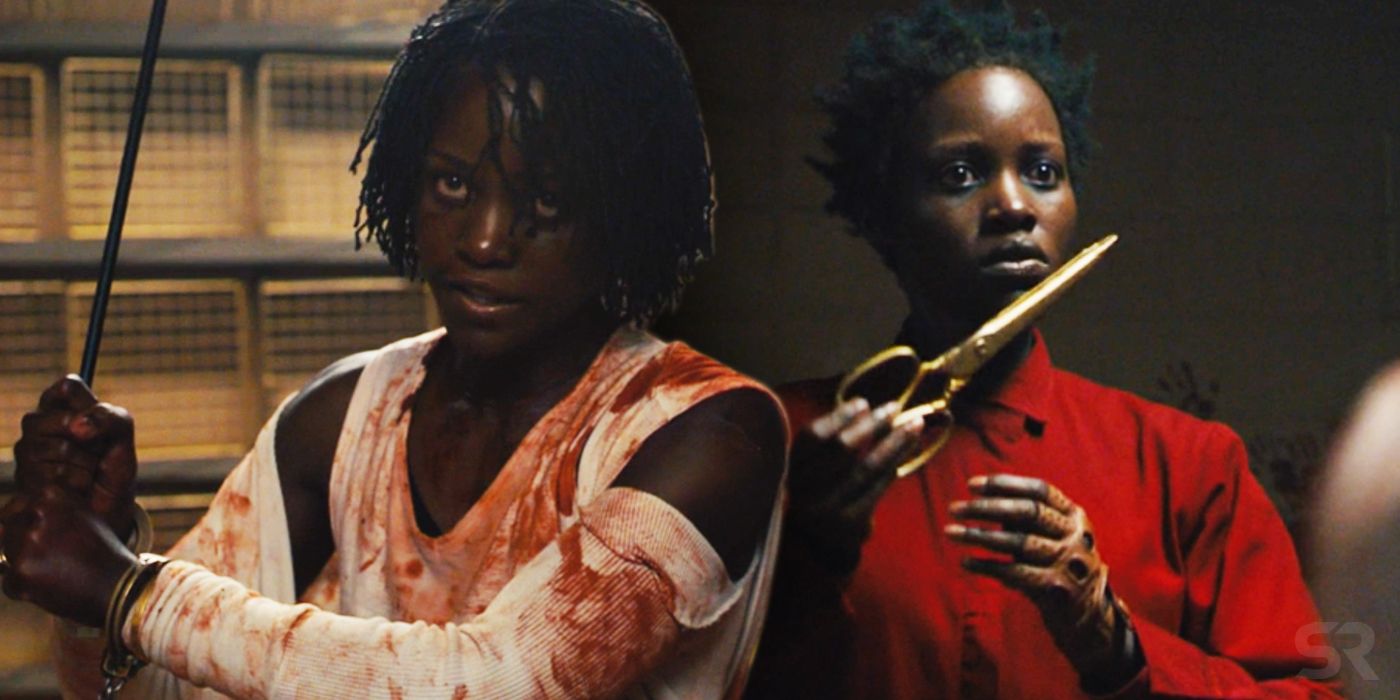
There are already a lot of people out there tagging all the Easter Eggs, the various connections, and parallels in the movie. I’m only going to talk about those things a little bit. If you want more of that sort of thing, there are a billion Youtube videos for it, but I want to talk about the themes, and subtext occurring in the movie, because that’s what I find the most interesting. The movie has so much depth, so many things are addressed, and have real life parallels, that the movie can be viewed through almost any lens, I want to talk about some of the top themes through which the movie can be understood:
Folklore
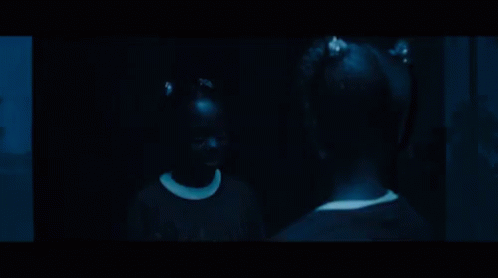
There is the German construct of the Doppelganger, which is an apparition, or double, of a living person. There is a significant body of folklore that deal with people seeing their own double. Traditionally, seeing one’s double was often a portent of death, and that piece of folklore is what’s being applied in Us. It is said that everyone in the world has a twin somewhere, and in some cultures, it’s said should you meet your double, you should kill it, because there can be only one of you.
There is a lot of doubling and mirroring in the movie, from Adelaide’s and Red’s reflections, to the neighbors twin girls, who speak in unison, to the numbers 11:11, which is a “palindrome”, a word or set of numbers that reads the same in either direction. (There are several articles on the significance of those numbers. 11:11 is a bible verse about God forsaking those whose sins have come back to destroy them.)
In Celtic folklore, the doppelganger was known as a Fetch, and its purpose was to alert people that someone’s death was imminent, but the concept of the alter ego, and the “double spirit” is part of the lore of most cultures, and not always in a negative way, just as in the movie, some of the mirror images are benign.
Books and Movies

It’s also an idea that has found its way into many movies and literature, the most famous of which are Dr. Jekyll and Mr. Hyde, The Prince and the Pauper, The Man in the Iron Mask, Dave, Moon Over Parador, and the 1985 Ran. In The Prince and the Pauper type stories, the original ruler is often incapable or dead, and is then replaced by a twin of low birth, who sometimes triumphs in the originals place, which is basically the plot of Us.
Another popular trope is the Evil Twin, which has found its way into everything from Star Trek to Gilligan’s Island, where one of them is unaware of the existence of their double, and their differences in upbringing is what accounts for their different characters. In Us, we are meant to attribute Red’s murderous sensibilities, and difficulty speaking, to her upbringing among the Tethered, and there are distinct parallels between the Jekyll and Hyde narrative.
Adelaide is meant to reflect innocence, as evidenced by her white and neutrally colored wardrobe, at the beginning of the movie. As the movie progresses, as Adelaide keeps killing, violently defending the life she usurped from the original, her clothes get redder and redder, to reflect her true nature. We watch as she becomes more and more her true self. But where Jekyll’s story ends in suicide, Adelaide’s ends in triumph.
One thing I’ve not seen discussed is Lewis Carroll’s 1865 Alice’s Adventures in Wonderland, as a theme. The symbol of the white rabbit (which is in the movie’s logo) is meaningful because it is one of the few types of animals that have ever been cloned, and is often experimented on. Also, in the original tale, Alice follows a rabbit into a hole in the Earth, where she finds a hall with many locked doors. This is what happens in the movie when Adelaide, chasing her doppelganger underground, finds a hall of locked doors, and rabbits everywhere. The rictus grins of the Tethered remind me of the Cheshire Cat’s phantom grin from Alice’s adventures. These are grins that do not indicate humor, but menace.

There’s also the parallel to the numerous mythological themes of people visiting the underworld to rescue (or destroy) something, called a Katabasis. In a Katabasis myth, the protagonist travels through the underworld, on a mission of retrieval, and this is featured in everything from The Ring of the Nibelung, to The Aeneid, to The Odyssey, persisting across many cultures, from Egypt, to Greece, and even South America, which features the myth of the Hero Twins of the Popol Vuh, who go into the underworld and win a ballgame, to avenge the death of their father.
After Adelaide’s son, Jason, is kidnapped by Red, she must go underground to rescue him, echoing the Greek myth of Orpheus and Eurydice, Jason’s doppelganger is named Pluto, the Greek King of the Underworld. It is also theorized by some that Jason is actually a Tethered. That Pluto switched places with him at least a year before the events of the film, so Adelaide is really rescuing her actual son.
Socio-economic/Political

Race
The movie can also be seen through the lens of socio-politics, and race. Peele says the movie isn’t specifically about any racial issue, but the subtext is there, because the story involves a Black family, and introduces the idea of “double consciousness”. Double consciousness is a term coined by the writer W.E.B. DuBois in his 1903 literary work, The Souls of Black Folk, a series of essays about the psychology of Black people. It is a state of mind specific to people of color, whose thinking is divided between who they think are, and what White people think they are.
Understanding W.E.B. Du Bois’ Concept of Double Consciousness …
There’s who I think I am, which is settled, often uncomfortably, next to how I know I’m viewed by White people.
Adelaide is an example of this in that she knows who she is, and wants to be, vs the above ground world’s perception of her. She dresses to not draw attention to herself, to seem just like everyone else and blend in. Adelaide, like many immigrants, or those from a different social class, tries to hide her impoverished background by assimilating into her adopted culture. As she fights Red to keep the status to which she’d become accustomed, more of her true background reveals itself.
Economics
Adelaide has moved up in the world by violently condemning her counterpart to a life of hell. (There is the strong implication in the film that Red was raped/impregnated by Gabriel’s counterpart, Abraham.) There is also some amount of survivor’s guilt for Adelaide, as she did nothing to rescue any of the other Tethered, and lived a life of luxury, knowing that her comfortable life was built on someone else’s misery. This is a question that successful Black people, from humble circumstances, often wrestle with. How much responsibility do they have to the community they left behind on their way out of poverty? Are they truly their brother’s keeper? Red seemed to have no problem answering this question, as she organized the release of all the Tethered from below, but then her ambitions were fueled by rage at what had been done to her. What was Adelaide’s excuse for leaving the other Tethered behind?

In fact, the Tethered are an allegory for those who most people consider “beneath” us. The laborers and workers who are invisible to us, but help our society run more smoothly, and who we often think of as less than, often not even bothering to learn their names. In the movie, the Tethered don’t have names, with the members of Red’s family being the only ones with names she gave them.
Those who live above ground (the privileged) can pass their sins on to some other group of people and thereby declare their innocence, and ignorance, to the misery which sustains their lifestyles, to be justifiable. In America, White people often project their worst qualities onto other races of people. In declaring that some sin is a problem for some other group, they don’t actually have to look at their own behavior, acknowledge the pain they have caused, or fix the problem. Black and Indigenous people have often been the scapegoats of White pathology, as they stereotype us in terms of actions they have committed themselves.
Red isn’t just angry because her life (her agency) was stolen from her. She tells Adelaide that for every good thing Adelaide experienced above ground, Red experienced some hardship, or misery, in equal measure down below. The Tethered represent the “laborers” of modern society, the people who take care of the minutiae of our day to day lives, freeing us up to pay attention to those jobs we think are more important, because we went through more years of schooling, or get paid more money to do. We place our burdens on their backs, so we don’t have to carry them, and then refuse to think about how the comforts of our lives are built on their impoverishment.
https://www.popsugar.com/entertainment/Why-Do-Tethe red-Wear-Brown-Gloves-Us-45958045
This theme of mistreated laborers is reflected in the Tethered manner of dress, and I can see parallels to themes from the 1927 film, Metropolis, in which the workers of a technological society all live in ceaseless, dangerous, labor in the bowels of the city, while the rulers have lives of luxury oblivious to what’s happening beneath them. One of the rulers son’s trades places with one of the workers in the underground, and with the help of a robot named Maria, causes a rebellion.

Most Americans don’t think about the uniformed maids, janitors, maintenance, and sanitation workers, until something stops working. If you have ever visited a large public venue, like a theme park or a zoo, you might or might not notice the uniformed housekeepers and maintenance workers who slip in and out of disguised doors to keep the place clean, and make our stay comfortable, and this is very much a statement on how Americans live everyday.
On a larger scale, most Americans don’t think of the many wars, that never reach our backyards, and the underhanded behavior that this country has engaged in, to steal other country’s resources, to make American lives comfortable. Our government has engaged in a great deal of global destruction, which we rarely we think about because we don’t have to worry about a drone strike hitting our Wedding party. Even when we do worry about such things, we have often been completely misinformed as to the true causes, and do little or nothing to resolve it. Just as the Tethered are Shadows of us, they exist in a Shadow America, where their lives are controlled by mysterious others who live above them.
https://www.hollywoodreporter.com/heat-vision/us-was-movies-biggest-twist-hiding-plain-sight-1196584
But really, all the characters are Us, as no matter how we behave, we can always justify our behavior by telling ourselves we are the hero of the story. Us is a movie in which everyone is committing justified violence against the other. As righteously brutal as the Tethered are in their revolution, The Wilsons are every bit as brutal as the Tethered in the protection of their family and privileged lifestyles. One can make the argument that the Tethered started it, and that the Wilsons were just defending themselves, but that stance does not take into account the decades of misery the Tethered had to endure, so that people like the Wilsons could live free.
Psychological
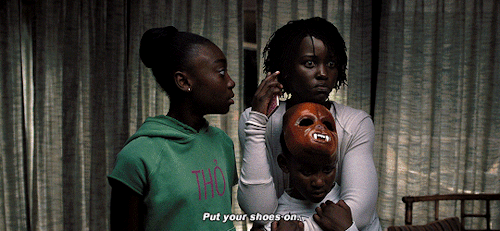
When you think about it, Adelaide’s development stopped at around age twelve, so she has all the rage, planning, and mindset, of a child. Children in their early development often focus on a sense of fairness, and equality, something Red specifically states to Adelaide. That what happened to her was not fair.
Americans cherish their ideals of fairness. And American children can be especially strident—some might say loud—advocates for equality. Anyone who has ever painstakingly cut and distributed a child’s birthday cake knows how closely those little eyes watch for injustice. And when they see it, especially in their ever-so-slightly-smaller slice, they protest with the anguished cry: “No fair!”
https://www.bu.edu/research/articles/child-development-fairness/
In Jungian psychology there is the idea of the Shadow Self, that dark part of oneself that one tries to ignore or bury. The Shadow is everything about yourself you try hard to forget is there. The Tethered represent our worst selves. They are our dark side. Adelaide has worked very hard to forget where she came from, but it turns out that Adelaide is actually the Shadow of Red. It is not until after you’ve watched the movie that you realize that it was Adelaide who was trying to ignore her original sin of trapping Red in the underworld. Sooner or later she knew this would come back on her. The message seems to be that every sin you commit will eventually come to back to bite you in the ass.
The logo for the movie features an example of a Rorschach Test, a test in which a therapy patient interprets meaning from inkblot images. The meanings determined gives the therapist clues to your character or personal issues. This is a reference to the film itself, which is a kind of Rorschach test for the viewer. The movie has so many facets, so many themes, which ones the audience focuses on tells a lot more about the audience.
Here take the Us rorschach Test, and see what your responses tell you about you:
Movies to Watch After Seeing Us:
Invasion of the Bodysnatchers (1978)
Single White Female (1992)
Metropolis (1927)
CHUD (1984)
The Nightbreed (1990)
Donnie Darko (2001)
Us is being written about and discussed as much as Get Out. This is what we all do now. Analyze movies, I guess!
https://www.elle.com/culture/movies-tv/a26988747/us-movie-review-horror-tropes/
https://www.polygon.com/2019/3/22/18274732/us-twist-ending-explained-spoilers

https://www.polygon.com/2019/3/27/18284361/us-movie-spoilers-tethered
Umbrae (Shahidi Wright Joseph), is referred to as a “little monster” by her mother, Red (Lupita Nyong’o); though she shares her double’s talent for running, it’s the addition of a permanent, eerie grin that brings up shades of how young women in particular are always expected (and instructed) to smile. She’s manifesting the image that’s projected onto her in the same way that her father is.
**In Part Two of The Meanings of Us let’s talk about the invasion plot in movies, what it really means, what its a stand in for, and how its applied in this movie.
